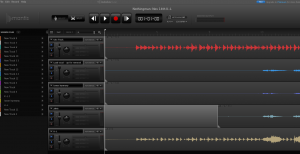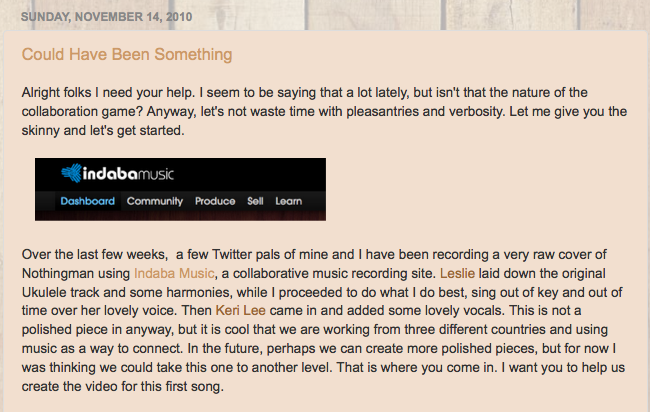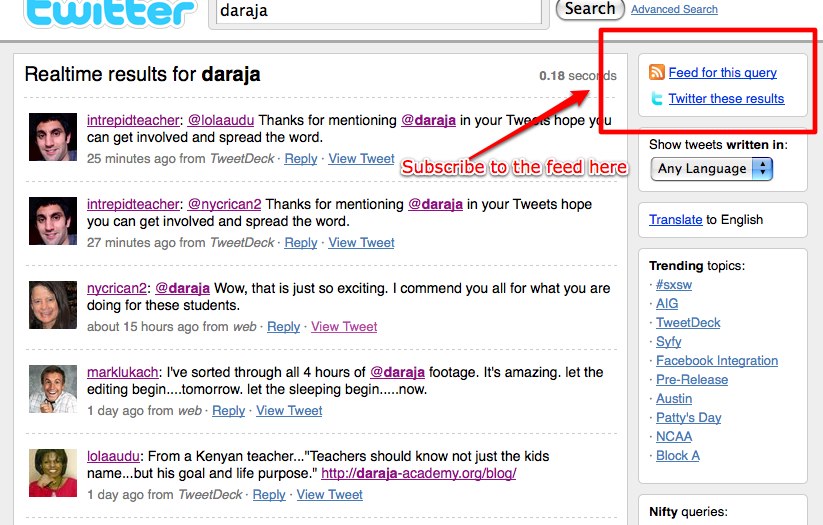There is a lot of talk these days on the Interwebs, and I suppose for many days before now, about the new ways in which people are communicating, collaborating, connecting, and creating online. Eager teachers are promoting the use of the web in almost zealot evangelical ways, trying to convince everyone that the world will fall apart if their students are not creating Glogsters instead of posters, or having Skype calls with a class in India or Indiana.
I agree, for the most part, with the passion exhibited by these wide-eyed teachers. It is clear that we are in the midst of a monumental shift in the way human beings not only communicate and share reality, but more importantly in the ways we create and share stories. I am always asking myself, what does this all look like? Always the eager student (much more fun than being a teacher) I am always trying to push the ways I use my network. I want more form my PLN, Personal Learning Network ( I shudder at using those three letters, but can’t think of a better word yet.) than to troll through links to blog posts extolling the virtues of Web 2.0. I want my network to be a living breathing part of everything I do. I want to allow you into my spirit and see what comes out. I want to enter your reality and make a mess. I want to make you think. I want to rearrange your mental furniture. I want you to do the same for me. Nothing will be learned as long as we stay behind walls and peak out from the edges. If you really want to know what this web can do, come on out at play.
I don’t think this level of connection is possible without letting down my guard and being open to any and all opportunities to make as many connections as possible. This philosophy has opened so many strange doors for me in the last three years, that I can’t help but want to explore it further. Sure, I want to help expose my students to what it looks like to connect with people worldwide, but I am in the process of seeing what this looks like for myself.
These networks, this web has to be more than what we say it is. If there is more to the web, than what we have seen so far, how powerful could it be? How far can we push this idea of connectedness? Ultimately, I want to make authentic, lasting, powerful connections with the people I interact with online, but all that is theoretical mumbo jumbo. Let’s see what this looks like:
A few months ago I attended the Learning 2.010 conference in Shanghai where I met several people I had known quite well for a some time. These are people I have worked with and met in “real” life. I mention this only because apparently face-to-face meetings make relationships more authentic. The real reason I went to this conference, however, was to meet the other people, the ones who I had never met. This post is meant to be about a song, so let me try and stay on course. Long story short, I met several people and we found ourselves sitting at a bar talking about life, the Internet, teaching, music, freedom, revolution etc…
Leslie was one of those random, (I mean random in the best use of the word), connections who had joined our newly formed cohort. For the sake of brevity, I will let her tell you the story from her point of view. She does a great job of writing about it here.
I think that brings us up to the song. Here is that story: @onepercentyello, @klbeasley and I used Indaba to record a cover of Pearl Jam’s Nothingman. It was pretty simple really, I had known Keri Lee for almost a year through Twitter and our blogs. We hit it off really well when we finally met. That night in Shanghai @klbeasley gravitated toward @onepercentyello’s Ukulele and voice. I can’t remember exactly how we reconnected after we returned home, but there was surge in Tweets and someone mentioned that we should record a song together. I sent out the Indaba link and within days, @onepercentyello had laid a simple track with voice and Uke. I added my part a few days later and with a few gentle nudges @klbeasley added an amazing track with her voice.
The song could have been a bit more polished, and next time it just might be, but for our initial attempt it turned out pretty well. Once it was done, I couldn’t help but think that it had a soul but no body. I wanted a way to get more people involved and find a way to present it back to the webs. I am trying to drive this web 2.0 as fast I can get it to go. So I wrote this quick post and waited:
Over the next few weeks I sent constant reminders and watched the photos come trickling in. Interesting that no one from my “real” friends on Facebook even acknowledged the project, but the following people from Twitter sent images:
@cogdog
@klbeasley
@marklukach
@onepercentyello
@MaryAnnReilly
@b_sheridan
@fceblog
@Cayusa
@moominsean
This is by no means a @zefrank project, but I feel it is special in it’s own way. Three people living in three different countries who had never met a few months ago made music together. Then another group of unrelated people felt a strong enough need to send images to a song many of them may have never even heard. I can write all night about the implications of a project like this, but I will let you do that in the comments. The important thing is the art we created. Without further adieu, nothing man:
So am I wrong? Is this not a big deal? What does a project like this mean to you and your classroom? What have we learned about ourselves, art, our new reality? I will wait to hear from you before I comment further.
But it is not over yet! What can you now do with this post, this song, this video? Looking forward to hearing your thoughts. We are already talking about the next song ( I am leaning toward this one.) and maybe a name for the band. What do you think? Do you want to be involved? Leave it all in the comments where it belongs!







